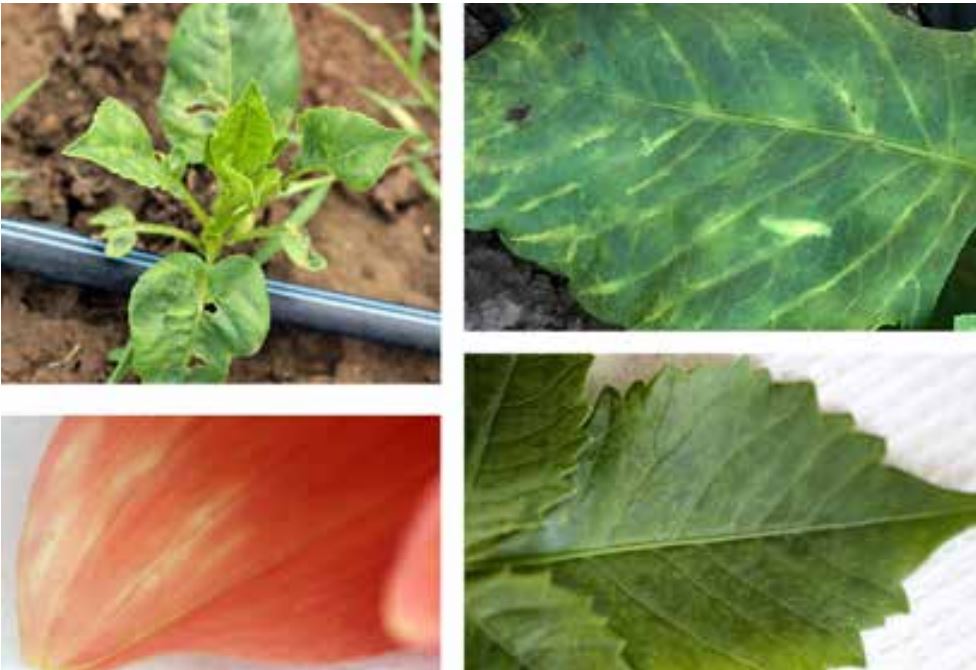
Symptoms of Dahlia mosaic virus include stunting (top left), vein-clearing on leaves
(top right), color breaking on petals (lower left), and mosaic patterns (lower right).
Dahlia Mosaic Virus
Dahlias are popular in Utah’s cut flower industry, but can be affected by viruses. The USU Extension Plant Pathology lab identified several viruses in dahlia plants collected from Utah farms as well as in tubers and seed purchased from suppliers. One of the most common viruses was Dahlia mosaic virus (DMV).
DMV is a DNA virus in the genus caulimovirus. It is transmitted by aphids and carried over in seed and tubers. There are three strains: DMV-D10, DMV-Holland, and DMV-Portland. To date, the most common strain found in Utah is DMV-D10, followed by DMV-Holland. DMVPortland occurs only occasionally. In some plants, two or even all three strains have been identified (Table 1). The strain found so far in seed is DMV-D10 (Table 2).
DMV causes many different symptoms, and it is currently unknown what affects symptom development. Some plants may show no symptoms at all while others are stunted, have mosaic patterns, vein clearing on leaves, or develop necrotic lesions. In some varieties, leaves are distorted and color breaking may occur on infected flowers. Moreover, stunted plants frequently do not produce marketable flowers.
In some cases, the symptoms could be caused by several viruses, including Tomato spotted wilt virus or Tobacco streak virus. To determine the virus and prevent its spread, farmers must submit plant samples to a plant pathologist for molecular- or antibody-based testing. DMV can spread during the growing season by aphids that acquire the virus while feeding on infected plants, called secondary spread. The aphids deposit the virus in healthy plants during feeding. Insecticides to control aphids are not very effective since the aphids do not stay on the same plant for a substantial amount of time. Many unanswered questions about DMV exist, and Drs. Claudia Nischwitz and Melanie Stock will address some of them in summer 2021, including transmission of the virus during cut flower harvest, associating DMV strains with specific symptoms, and a greenhouse trial to determine susceptibility of popular dahlia varieties. To prevent DMV, start with healthy, virus-free tubers or seed. However, because these are difficult to source, testing your own stock is an option. Farmers that plan to overwinter tubers for next year’s cut flower production can get up to 20 plants tested at USU, paid for by a grant. If you are interested in having some of your plants tested, please contact Claudia Nischwitz or Melanie Stock.
Table 1. Distribution of DMV Strains Among Sample Types
| Seed | Tuber | Leaf | All Types | |
|---|---|---|---|---|
| H only | 0% | 25% | 12% | 14% |
| P only | 0% | 3% | 0% | 1% |
| D only | 54% | 11% | 8% | 20% |
| HP | 0% | 0% | 2% | 1% |
| HD | 0% | 14% | 29% | 17% |
| PD | 0% | 3% | 0% | 1% |
| HPD | 0% | 0% | 10% | 5% |
| Total | 54% | 56% | 61% | 58% |
Table 2. Incidence of DMV Among Sample Types
| Seed | Tuber | Leaf | All Types | |
|---|---|---|---|---|
| H Total | 0% | 39% | 53% | 36% |
| P Total | 0% | 6% | 12% | 7% |
| D Total | 54% | 28% | 47% | 42% |

